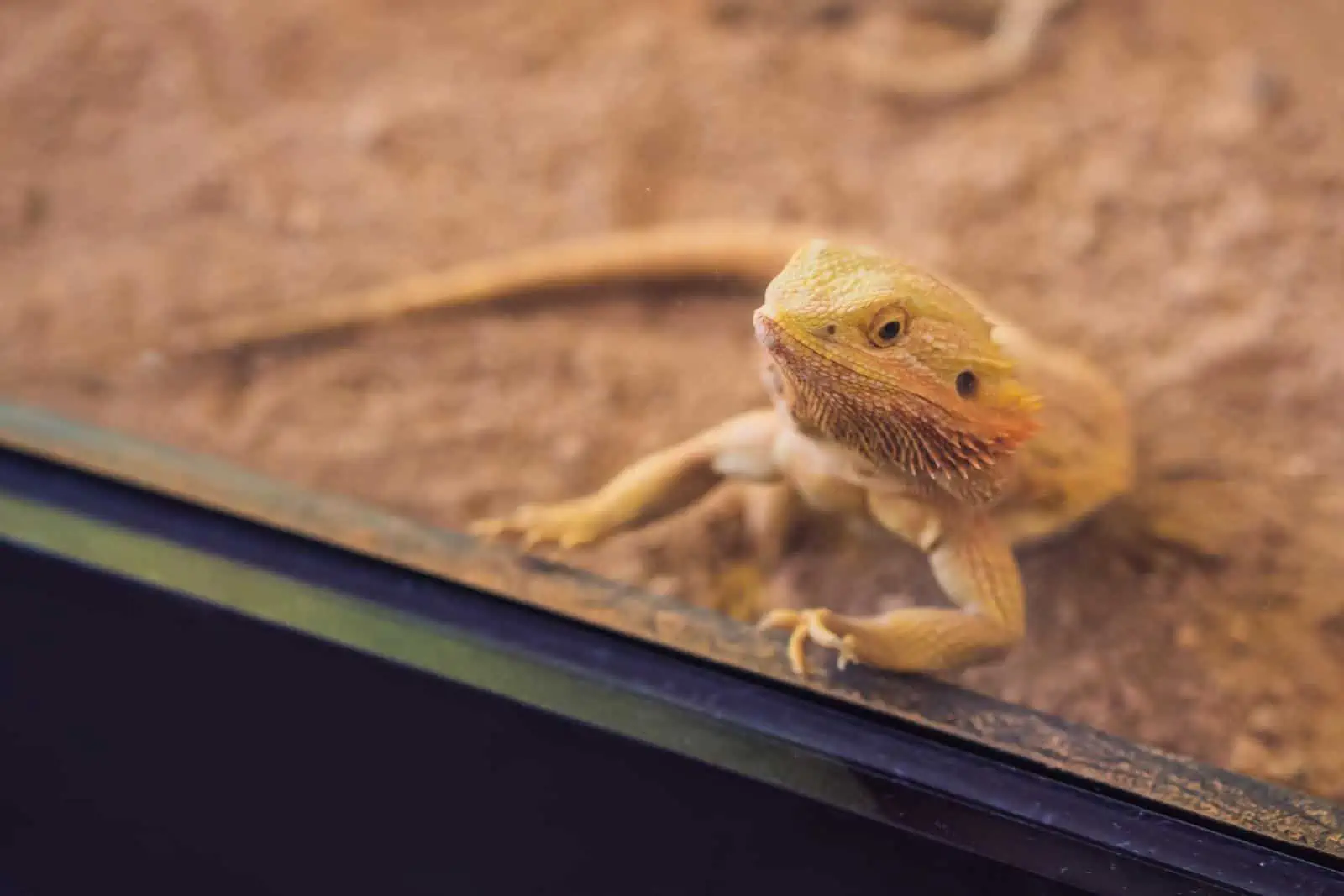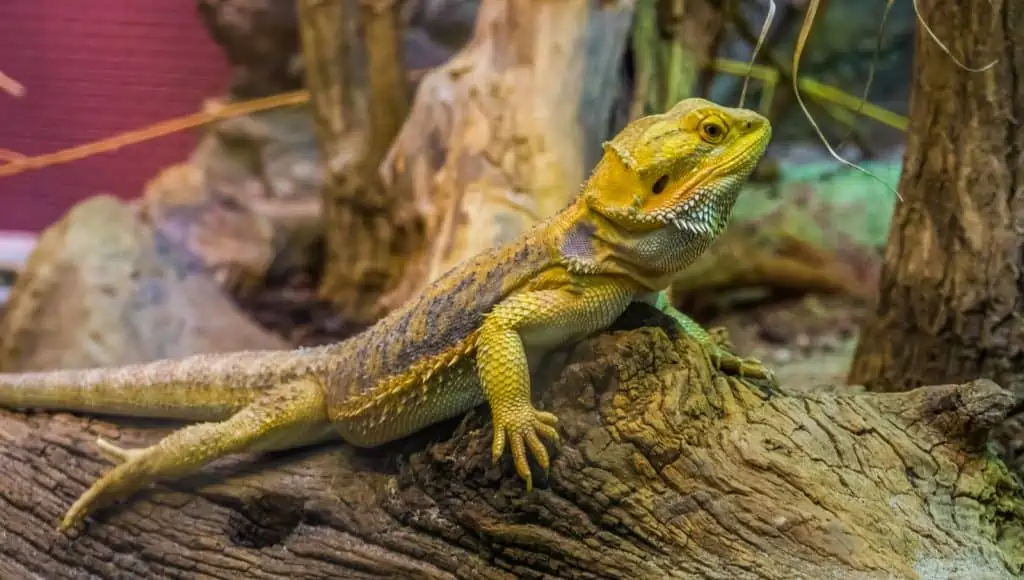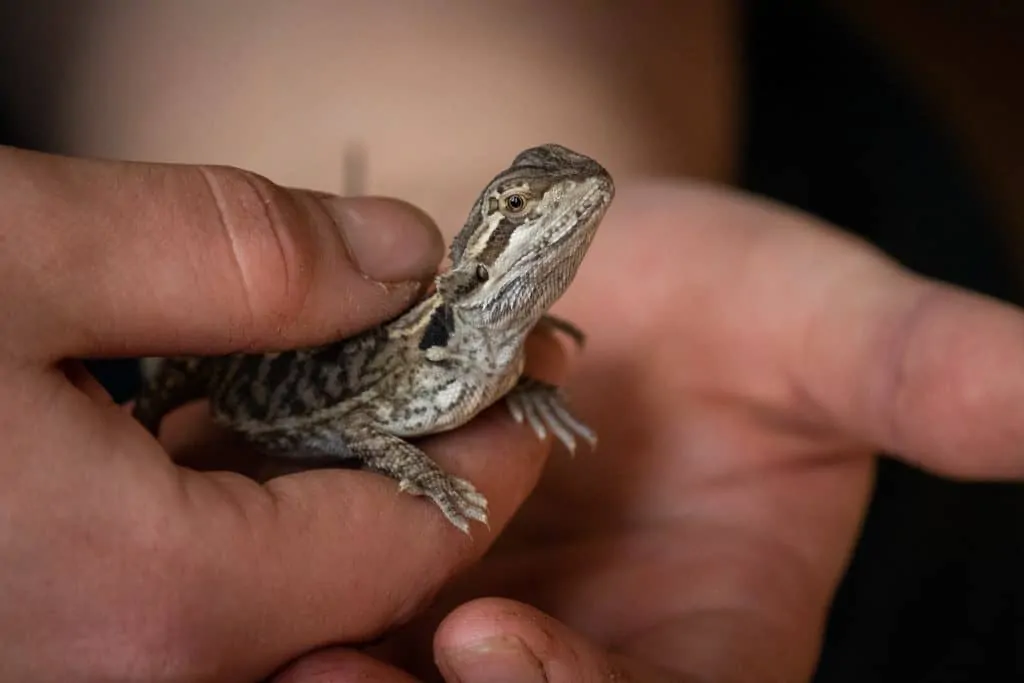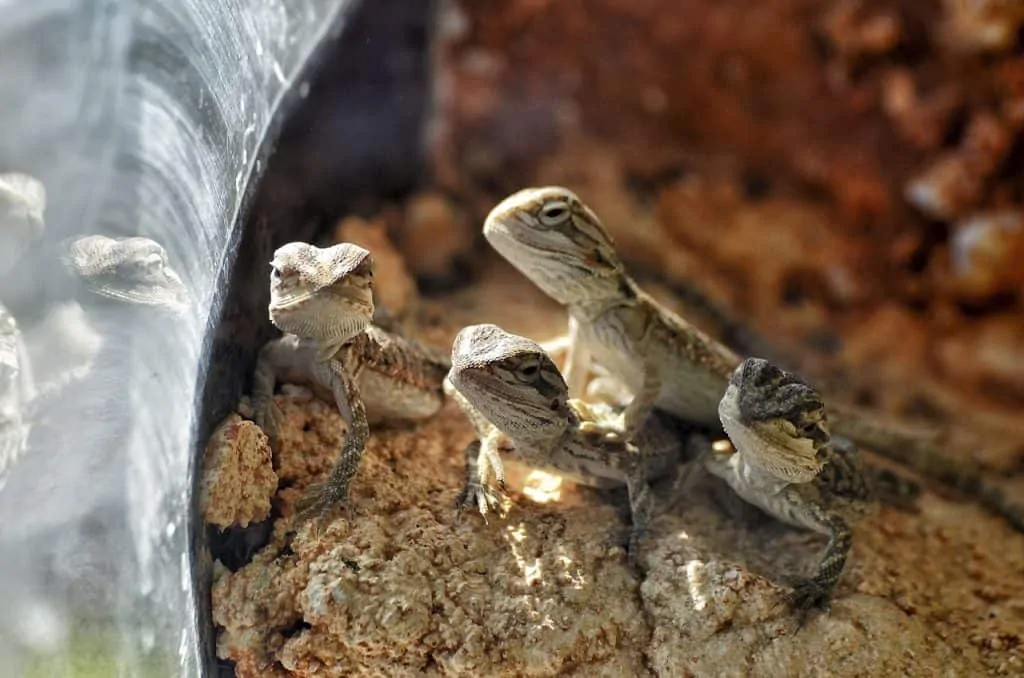People get all enthusiastic about choosing their pet. Understandably, this act gets the better part of our focus – big or small, Bearded Dragons are adorable to look at, and there are so many gorgeous individuals of various morphs to choose from.
However, equal attention – if not more – should be dedicated to choosing a perfect habitat for your pet dragon. As a first step, selecting the correct enclosure size is essential since beardies require a lot of space to develop and live happily.
The right-sized terrarium, in which a beardie can move safely without restrictions, plus have proper decoration and equipment, is a fundamental condition for a comfy and stress-free reptile life.
To help you, I’ve put together some important topics to consider when selecting an ideal tank size for your Beardie!
In this article, we’ll explore the following topics.
- The life stages and space needs of bearded dragons;
- Determining the right size of tank based on your dragon’s age;
- Choosing the right tank for a hatchling or juvenile dragon;
- Buying a tank for an adult bearded dragon;
- Cohabitation and safety issues to look out for when buying a tank;
- Bearded dragon tank ideas and recommendations.
Get your measuring tape, and let’s go!
What Is the Best Bearded Dragon Tank Size?
The quick list of best-suited bearded dragon tank sizes goes like this:
- Hatchlings: 40+ gallons (with 20 gallons being temporarily acceptable)
- Juveniles: 50+ gallons
- Adults: 75+ gallons (120 gallons is ideal).
Understanding bearded dragons’ life stages and needs results in real knowledge of the tank size’s importance. A deeper understanding will help you avoid common pitfalls (e.g., Glass Surfing) and possibly save money when buying the tanks.
In their lifetimes, bearded dragons will grow from 3 inches as hatchlings to the full adult size of 16-24 inches at a monthly rate of 1-2 inches. Undoubtedly, the tank size needs to follow up on that growth.
The tank dimensions are also important. Floor space is the key – your beardie should always be able to move freely and turn in a circle without bumping into tank walls. That means you should take special care about the tank width. Enclosures that are long but narrow may seem decorative, but they are not suitable for the beardie’s need for movement and exercise.
I’ll be blunt: the easiest thing to do is to get the adult-size tank from the start. This is more expensive in the short run but saves you a lot of hassle later. Although having a tiny juvenile in a large tank may seem ridiculous initially, you are not obliged to get a smaller, “fitting” tank and a larger one later. You can easily get the big one from the start.
Another useful rule – bigger is always better. Get the largest tank possible, and your bearded dragon will be grateful.
Determining the Size of the Tank by Your Beardie’s Age
Here is a more detailed list of perfect-size tank matches for different beardie age categories.
- The minimum tank size for a baby (hatchling) bearded dragon up to 10 inches in length is 20 gallons, with 40-50 gallons being desirable.
- The juvenile beardie tank’s optimal size is 40-70 gallons.
- The best size of an adult bearded dragon tank is 75-120 gallons (and even more if you have the space).
Why Does Your Bearded Dragon Need a Big Tank?
As you can see, the right, bearded dragon set-ups require quite a lot of space (and investment). But why is that? Aren’t reptiles supposed to be pets that are relatively compact to keep?
Bearded dragons are medium-sized lizards, but they can be very active. In their natural surroundings, they are territorial – males keep a chunk of land for themselves and their females and ward off or attack intruders. Thus, although they don’t roam around and are not always active, they have periodic bursts of high activity when hunting or defending their territory.
Of course, we can’t replicate the Australian outback in our homes (at least most of us can’t). However, the least we can do for our beardie’s welfare is to give them as much space as possible.
What Happens When a Bearded Dragon Tank Is Too Small?
The consequences of keeping a bearded dragon in a tank that’s too small for its age and size can be stunted growth, chronic stress, and disease. Despite reptiles not being expressive animals, if you take a closer and longer look at beardies confined in small cages, you can easily witness their discomfort.
When you see breeders keeping their reptiles in small-ish breeding racks, that is because they have a huge number of animals. However, keeping them confined like that long-term is not in their best interest, nor it meets all of their environmental needs.
It’s understandable, to a point. You could say that keeping reptiles in such a confined space is a “sacrifice” to be able to produce cool morphs and a sufficient number of animals. Of course, it’s also probably the only way for breeders to profit. However, this is not a recommended way to keep pet reptiles once they’re out of the breeding operation.
What Tank Size Does a Baby Bearded Dragon Need?
Hatchlings and juvenile bearded dragons are easier to hatch. If you are in trouble with finances, you can settle for a smaller tank now. However, please be responsible and plan to replace it with an adult-size tank in time.
As said, the minimum size for baby dragons is 20 gallons, but preferably 40 gallons.
Dimensions also matter, and you need to keep in mind. The tank must be long and relatively wide, but it doesn’t have to be too high. A 20-gallon tank measuring 24 x 12 x 16 inches is one example of proper sizing for a young beardie.
There is one phenomenon to look out for. I’ve seen it too often – people get a juvenile lizard with the right-sized tank for their age but fail to replace it in time. Consequently, the pets start suffering from ill health – and you can see they’re stunted and unhappy.
Don’t fall into this trap. Bearded dragons can reach their adult size in only 12 months! In other words, if you got a bearded dragon starter kit for Easter, order the adult-size enclosure for Christmas.
Also, when selecting a tank, remember you must fit in equipment such as heating and lighting (more on that at the end of the article).
Adult Bearded Dragon Tank Size
What tank size does a bearded dragon need fully grown? The answer is simple: the bigger – the better, and always be mindful of the minimum requirement.
As said, once your beardie reaches adulthood, it will require the largest tank size to ensure they have enough room to move, eat, bask, and live and be a bearded dragon comfortably.
There are much larger reptiles in the hobby than beardies, but at up to 24 inches as adults, they’re far from small. As a consequence, they require a spacious tank to thrive. The adult tank is where your beardie will spend the rest of his life, so don’t save up on it.
The most humane minimum size for an adult bearded dragon is around 75 gallons. Some sources recommend a 50-gallon minimum, but in my experience, things would get too crowded. Again, the bigger the tank you can get, the better.
Moving to a larger enclosure also means larger hides, larger water bowls, and larger everything. And more powerful heating and lighting as well. Don’t forget to consider these extras when calculating the expenses regarding adult beardie enclosure.
You don’t need to move the geriatric bearded dragons to a smaller tank, even if they move around and exercise less. Again, the adult tank is the enclosure for life.
Can You Keep Multiple Bearded Dragons In a Single Tank?
Many of you wonder, “If I have to get such a large tank, can I at least put a few beardies in there?”
If that’s the case, then welcome to the controversial topic of bearded dragon cohabitation.
I’ll be open with you. We do not recommend cohabitation for bearded dragons. Keeping two or more bearded dragons together can lead to biting, fighting, and injury. The fights can occur due to territoriality or, more commonly, food disputes.
A bite might not sound like a big deal, but considering that beardie tanks are usually far from sterile and can harbor germs, any wound can become an infection. And reptile infections can be challenging to treat.
Still, there will always be people willing to risk cohabitation, claiming that bearded dragons like to keep each other company. I don’t like to judge or scrutinize these hobbyists. However, be aware that the decision comes at a high risk.
If you are still dead set on housing two beardies together, make sure they’re both females and that you never feed them together.
Bearded Dragon Tank Recommendations
Don’t know where to start looking for an ideal bearded dragon terrarium or at least to get inspired? Then check out some of our bearded-dragon-friendly enclosure recommendations.
Juvenile Bearded Dragon Tank
With 36″x18″x18″ dimensions, the NEPTONION 48-gallon glass enclosure with an aluminum frame is an excellent option for juvenile beardies. This terrarium is well-designed, with plenty of nifty features.
- The sliding doors have a lock, so an explorative beardie can’t push them open – a very important safety consideration.
- The aluminum frame guarantees both light and sturdy construction.
- There is an 18-month warranty included.
The drawback is that this terrarium is on the pricier end of the spectrum, and you’ll need to replace it as your beardie reaches adulthood. On the other hand, you can use it for another reptile and as a spare tank whenever you need it.
🏡 Find the NEPTONION 48-gallon glass enclosure on Amazon
Adult Bearded Dragon Tank
Measuring 120 gallons and 48″ x 24″ x 24 inches, Reptizoo’s Large Reptile Terrarium meets all the requirements to become a life-long beardie home. It’s all tempered glass, with sliding doors and a mesh lid.
Here are some of the perks of this enclosure.
- Security. This tank has an anti-escape lid and a security lock on the sliding door, preventing your beardie from escaping.
- The larger-woven screen top allows both good ventilation and UVB penetration. Good airflow is crucial for beardies as they need a drier environment.
- The raised waterproof bottom plate adds good ventilation and creates space for floor equipment such as an under-tank heater.
- All-glass terrarium sides allow a full view of the beardie habitat.
Also, it’s helpful that the manufacturer ensures secure packaging for such a large and easily damaged tank and offers free replacement for any parts damaged in transport.
🏡 Find the Reptizoo’s Large Reptile Terrarium on Amazon
Other Considerations When Buying a Bearded Dragon Tank
When deciding on the right tank, there are more considerations than the mere volume and dimensions of the enclosure.
- As I mentioned, you need to ensure that all the equipment – the lamps, the heaters, the hides, the substrate, and the decorations – will fit into the tank well.
- Also, beardies need tanks with sufficient floor space – long and wide, not tall. If you see a good deal for a large tank taller than it’s long, you better find another one.
- It’s best to get one with sliding doors on the front for large tanks. This type of enclosure is easier to access and clean, plus it makes feeding easier. Also, any lizard will feel more secure and relaxed if you’re not staking and catching them from above.
- Suppose you are worried that your beardie doesn’t have enough chance to move around. In that case, you can create an exercise space outside of the tank in a safe area (no loose pets or untended children, no toxic plants, no potentially falling objects, and no escaping opportunities).
Budget Issues
Financially, the “the bigger, the better” recommendation can be problematic. It’s true that is that large reptile tanks can be pricey, especially if all glass. If you’re on a budget, consider making a bearded dragon tank yourself or with the help of a local maker or carpenter. Depending on the current raw material price, a large tank with only one glass side and the rest being wooden can be cheaper than all glass or plexiglass (PVC) tanks.
Take a look at the enclosures at FairyTale Dragons. Utilizing the outdoor space (with the help of the warm Florida climate) and making the majority of structures from wood has allowed these breeders to keep their dragons in spacey enclosures while still having many lizards. Still, it would be better to have a transparent glass side on the front of the tank for home conditions.
👉 Check out our specialized bearded dragon habitat article for more information on creating an ideal habitat.
Summing It Up
Choosing the correct terrarium or tank size for your bearded dragon is one of the crucial steps in ensuring their well-being. A suitably sized tank, according to your beardie’s size, will provide your pet with enough space to live comfortably and meet their natural needs.
Not only do the right-sized housing and decorations keep our precious lizards stress-free, but they also create a safe environment to move around and get active. We can’t give them the vastness of their native Australian landscapes, but we can at least try our best to ensure a high quality of life in enclosures. And for that, they do need to be as spacey as much as the room and the budget will allow.
I hope this article has helped you tackle another vital topic regarding bearded dragon keeping. How do you imagine your perfect bearded dragon enclosure? Let us know in the comments!







